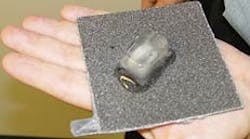The Microcell technology used in Firefly’s 3D and 3D2 carbon-graphite foam (see Figure 1) batteries represents a significant advance in lead-acid battery performance. The company has now teamed with NorthStar to bring the technology into production with advanced lead-acid battery manufacturing techniques. A large portion of the funding for this phase of development is provided by the U.S. Army, which has awarded Firefly a contract under its “Silent Watch” program. This is a project that seeks to develop batteries with sufficient capacity to power electrical equipment in military land vehicles during stealth operations.
Conventional lead-acid battery technology is the most mature and effective battery technology for vehicle electrical systems. Reflecting this fact, 95% of all military vehicles use the T6 lead-acid battery, according to a market study by Frost & Sullivan. However, the limitations of the technology, such as weight, slow recharge-ability, limited lifespan, sulfation and internal corrosion of the lead electrodes (see Figure 2), are equally well established. While power designers have used several clever techniques to compensate for these limitations (perhaps most notably the use of sophisticated charge monitoring, or the use of ultracapacitors in hybrid power systems), major advances in lead-acid battery technology itself hold the greatest potential for enabling new capabilities cost-effectively.
According to Mil Ovan, Sr. Vice President of Firefly, the fundamental advance embodied in Microcell technology is the use of carbon-graphite foam, which replaces the conventional lead grid as an electrode. During manufacturing, the foam is exposed to a lead slurry, creating a lead-coated surface having the dual advantages of greatly reduced weight and greatly increased surface area. The 3D battery uses a carbon-graphite foam for the negative electrode, and a conventional plate for the positive electrode. In the 3D2 battery, both positive and negative electrodes are made of carbon-graphite foam. These two configurations allow designers to optimize for either cost or performance.
Ovan states the lead-acid electrochemistry of conventional batteries is unchanged in Microcell technology. Rather, new physical geometries enabled by the use of carbon foam allow a greater utilization of the full energy potential of lead-acid battery chemistry. The theoretical limit for the chemistry itself is 170 Whr/kg. Conventional batteries harness only 30 Whr/kg to 50 Whr/kg.
This full utilization is possible because the new geometry brings all materials undergoing chemical reactions into closer proximity, providing the electrodes greater access to the full quantity of the electrolyte. It also expands the surface area of the electrodes, the sites where reactions occur. The increase in electrode surface area combined with the small distances between the positive and negative electrodes (through which ions must flow within the electrolyte, reduced from several millimeters to less than 400 μm) increases the reaction rate. The reaction rate in a lead-acid battery is electrically modeled as the internal series resistance, which in turn is a reflection of battery power capacity.
According to Kurt Kelley, CTO for Firefly, while exact comparisons are difficult, tests have been conducted that compare a 1-C rated Firefly battery discharged at a 5-C rate against a 1-C low-resistance, spiral-wound, lead-acid battery. At 93% state-of-charge (SOC), the discharge internal resistance of the spiral-wound was 11 mΩ, and for the Firefly battery this was 3 mΩ. At 10% SOC, this increased to 13 mΩ for the spiral-wound, and 4 mΩ for the Firefly battery.
In addition to these electrical performance advantages, there are mechanical and thermal advantages. Most notably, Microcell technology enables superior cold-temperature performance. Ovan states, for example, that a battery at -20°C using Microcell technology may have 60% of its room-temperature capacity, while a conventional lead-acid battery may have only 20%.
Also, because lead-coated carbon foam is much lighter than all-lead electrodes, total volume or weight reductions on the order of 50% over conventional batteries are possible, with faster discharge rates (under 1 hour) and cold temperature operations showing the greatest gains in weight/volume reduction. Another advantage derived from using foam is the ability to accommodate swelling caused by the production of sulfate crystals formed as lead-acid batteries are discharged, without the mechanical failure that can occur in conventional batteries. The smaller electrode geometries of carbon-graphite foam also keep these crystals small enough to be easily decomposed upon battery recharging, thereby preventing sulfation.
Among the more extreme potential applications for Firefly’s batteries is motive power for all-electric UAVs, given the increase in energy density and power density. However, there have been no specific announced projects to explore this possibility. For other applications, designers can learn more about Microcell technology through resources available on Firefly’s web site. For designers and integrators of military systems, the June 2007 issue of Defense Electronics magazine will include a contribution by Firefly providing an overview of Microcell battery technology in military power sources.


